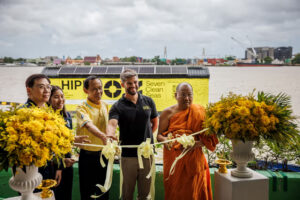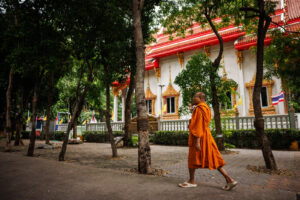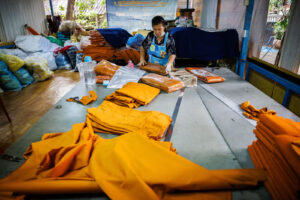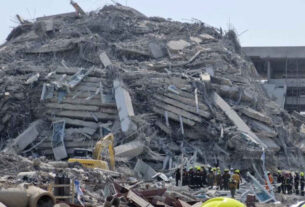 How a monk and a Hippo joined forces to tackle Bangkok’s plastic pollution
How a monk and a Hippo joined forces to tackle Bangkok’s plastic pollution
Desperate to restore the Chao Praya River to a pristine state, an abbot in the Thai capital began recycling in his temple. Now he has a floating ally in his efforts to clean up the river
Photographs by Lauren DeCicca
“Once upon a time this river was filled with fish; now, nothing swims in it any more,” says Wat Chak Daeng temple’s abbot, Phra Mahapranom Dhammalangkaro, as he looks out over Bangkok’s Chao Praya River.
As a novice monk in the 1980s, he remembers seeing children playing in the river and people scooping up handfuls of water to drink. But when he became abbot of Wat Chak Daeng more than 25 years later, those bucolic images were a thing of the past. Instead, when he arrived at the 240-year-old temple, he was saddened by the sight of the dirty river and the rubbish-strewn grounds surrounding it.
Dhammalangkaro knew that if nothing was done, the situation would only get worse. He built a recycling centre in the temple grounds, which evolved from collecting a handful of bottles to upcycling 300 tonnes of plastic a year. His biggest problem was that he was unable clean the river itself.
But then he met Tom Peacock-Nazil, chief executive of Seven Clean Seas, an organisation that finds solutions for plastic pollution. Last week the two men launched the Hippo, a solar-powered boat, which aims to remove 1.4m kilos of plastic a year from Bangkok’s busiest waterway.

“I want to take the waste from the river before it goes to the sea,” says Dhammalangkaro.
The Chao Phraya River is the largest waterway flowing through central Thailand. It stretches more than 230 miles from the northern Nakhon Sawan province to the Gulf of Thailand and is home to critically endangered species such as the Siamese tigerfish, giant barb and Chao Phraya giant catfish.
When people see the Hippo, it will make them curious
Chalatip Junchompoo
In Bangkok, it is an artery for a network of water buses, ferries and wooden long-tail boats. But it’s not just carrying people. According to research by the Rotterdam-based non-profit organisation Ocean Cleanup, the Chao Praya River carries 4,000 tonnes of plastic waste to the sea every year.
Plastic can be washed from the land into the rivers with the rain and floods, but even with penalties of up to 10,000 baht (£220), there are still people illegally dumping rubbish.
The Hippo’s design is simple and effective. A boom on the vessel funnels the floating plastic from the river on to a solar-powered conveyor belt. This then hauls the rubbish out of the water and drops it into a dumpster hidden under its roof.
The tangled mass of water hyacinths, food containers, plastic bottles and bags is then sorted by hand and recycled at the plant in the temple.

As well as removing rubbish from the river, Chalatip Junchompoo, a director of the Marine and Coastal Resources Research Centre, believes the Hippo’s presence will have an important impact by raising awareness of plastic waste. She views it as a welcome addition to its network of river booms and rubbish-collection boats.
“When people see the Hippo, it will make them curious,” she says. “They will want to know what it is and why it’s there.”
Thailand is aiming to have all plastic recycled by 2027, up from 37% now, according to the Pollution Control Department. Plastic that cannot be recycled is, where possible, used for refuse-derived fuel.

The Hippo team will work up to eight hours a day on the boat. But as the river is tidal, they know when the high tide will arrive – and increase their workload.
While sponsorship has helped cover the running costs of the Hippo, future expenses and maintenance will be paid for with plastic credits, which companies can use to offset their plastic footprint.
In Wat Chak Daeng, some of the plastic is sent to a factory to be converted into fabric. The fabric is then sewn by volunteer seamstresses at the temple into saffron-coloured robes for the monks, as well as blankets and bags.

Dhammalangkaro has a novel way to encourage people to send the monks their waste. “People can make [Buddhist] merits by giving us plastic bottles, bags and paper,” he says. According to the Buddhist faith, good thoughts, actions or deeds can equal a merit, which can help determine the quality of the person’s next life.
The monks can upcycle multilayered plastic, which is seen as challenging to recycle, thanks to a new machine that uses a chemical recycling method known as pyrolysis to break plastic down into oil. Any organic waste is converted into fertiliser using two industrial composters.
A marine iguana swimming in the sea
‘Currents bring life – and plastics’: animals of Galápagos live amid mounds of waste
Read more
The Hippo has created the final link in Wat Chak Daeng’s circular economy. Now the aim of the team is to build more Hippos to tackle other polluted rivers elsewhere in Thailand and south-east Asia.
Peacock-Nazil says that addressing rivers alone is not the solution. “We need to work onshore and in riverside communities to make sure they have the infrastructure needed to stop plastic leaking into the environment in the first place,” he says.
Seven Clean Seas, as well as extending its reach in Bangkok, plans to create educational programmes at a local level and would like to offer the Hippo as a floating laboratory for universities in the future.
“I really hope that one day we are made redundant, and we don’t have to exist as an organisation and Hippos don’t need to float in the river, but until that day we will continue to do what we do the best way we can do it,” Peacock-Nazil says.
Source: https://www.theguardian.com/environment/article/2024/aug/05/thailand-bangkok-plastic-pollution-chao-praya-river-abbot-buddhist-seven-clean-seas-hippo


